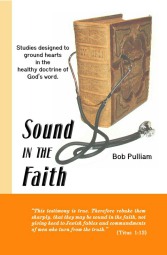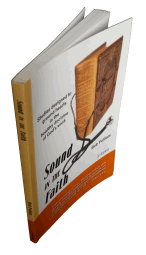
First, let me applaud those teachers who diligently work to establish new converts in the faith. We all know that a new convert is a "babe." At times, disciples who have been members for years are "babes" (I Cor 3:1). Instead of hoping your baptisms end in strong members of Christ's body, you study with them to assure that result. Sadly, I think we've all known of cases where that effort was not made. Thank you for your diligence.
The material before you was specifically developed for first studies with someone who has just been baptized into Christ. But this first principle aspect makes it valuable for students who will soon be going off to college, and for adult classes where a confirmation of first principles may be desirable. At times, someone moves into the area and tells you they want to set up a study. This could be a good beginning point. It has a tendency to get questions out in the open for discussion (e.g. organization and work of the church; instrumental music; attendance; etc...). I have used it to good effect in getting new members on a sound footing, when they might have otherwise floundered and fallen away.
You may have your own material that you've developed toward this end. If you have a wheel that works, I would never encourage you to replace it. But you may be looking for something to keep on hand for the occasions noted above. For that reason, I would like to lay before you the top seven benefits I see for your use of Sound in the Faith.
Seven Benefits:

For years, I used material I put together, printing copies for each class and handing them out. Knowing some of those diligent students, I have no doubt they kept the material; but looking back, I had to ask myself, "Would they actually be able to find that material now?" Keeping it (folding it up and stuffing it in a book) is of no value if you can't find it later. So I decided I needed to start binding material so the lessons would be a bookshelf item, rather than a stuffed-in-a-book item. The first material was done with a plastic comb binding. Not so "page turn" friendly, but much more likely to be placed on a book shelf. It was upgraded to a coil binding as plans and revisions started working toward a perfect-bound edition (what is many times called "trade paperback"). It has a look of professionalism (which was impossible for me to achieve by handing out loose pages), and is easily found on the book shelf (the title is on the spine). So, benefit #1 - A permanent fixture in your students' libraries.
Not every student will need lessons in the same order, but the lessons in this book are arranged for the most common need I have found through the years. For example, the material begins with a lesson on the nature of discipleship. How many times have you baptized someone, only to find them immediately visiting the denominations around town? Lesson one gets right to the heart of that problem. It also deals with the problem of new converts thinking they've now gotten salvation under their belt, and need only serve God when they feel like it. This lesson deals with "once-saved-always-saved", and urges a diligent discipleship. Everything from the nature of discipleship, to the disciple's place in the church, to family relationships, to the fruit of the Spirit - it's in Sound in the Faith. So, benefit #2 - Lessons your students need, right away.
Some of the people you baptize will come straight out of a background that emphasizes church authority over Scripture. From the beginning, these lessons emphasize the necessity of going to God's word for answers. Listening to people or emotions over Scripture is discussed, emphasizing the error in so doing. This is huge for keeping a babe from roaming around, and ending up in a church because it makes them "feel good". So, benefit #3 - Lessons that emphasize the authority of God's word.
Material is of no benefit if your student doesn't get it. I've used this material with students of various ages and backgrounds for many years. During that time, I've isolated misunderstood statements and either reworded them, or noted them in the teacher's edition. I've identified questions that were not helping students, and reformulated them to reinforce the material. In short, if it wasn't getting the point across, I changed it so it did. I'm not saying it's the best material for you to use (because we all have different styles and approaches to teaching), but it has been tested and proven for years, so you can be sure of what you will be getting. So, benefit #4 - Lessons that have been proven over time to do their job.
A 138 page perfect bound class book on the market today will typically go for around $8.00+. I developed this material to teach my students, not make money off of you. It is published with a minimal profit, which is actually used for copyright fees, postage, and various tools needed to get additional books published with this same rationale. Sound in the Faith is as inexpensive as I could possibly make it. My prayer is that your students be the winners who reap the profits. So, benefit #5 - A product cost that makes it reasonable for everyone who is interested.
Around 95% of the questions in this book are answered intuitively by the wording of questions compared back to sentences in the lesson. I've never had an eighth grader who couldn't answer the questions (sometimes better than their parents, because they weren't trying to over-think it). If the student can understand English, they will be able to answer the questions. Each lesson has three or four sets of questions scattered throughout. This gives a more extensive coverage of the lesson by the questions, and allows a more thorough evaluation of the student's comprehension. I've avoided the popular "thought questions" used in workbooks today because this material is aimed at new converts. I've found it important to get these important concepts through quickly, and allow the value of "thought questions" to be introduced later, in other material. So, benefit #6 - You will know if your students "got it," because of the extensive evaluation afforded by the numerous questions.
You hope that your students will pick up this material in the future and refresh their memories of truth in God's word. Emphasizing the two indexes in the back can help accomplish that. There is a short "frequently used passages" listing in the back, that offers a few critical subjects and related passages. And there is a scripture index for the lessons, allowing your students to go back and quickly find the location of any scripture used in the lesson portions of the book. Finally, benefit #7 - Indexes to provide additional functionality to this class book.
As you might imagine, I'm a little prejudiced about this material, but I truly believe you will find it beneficial in your teaching program.